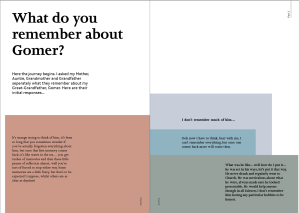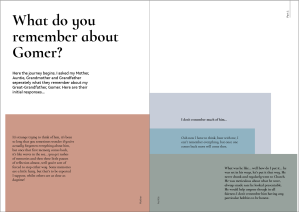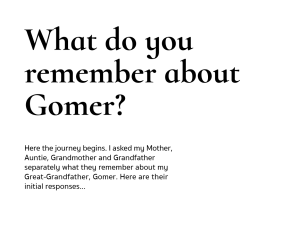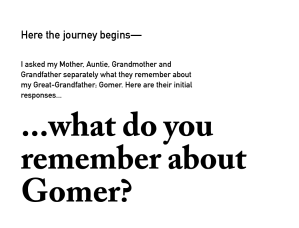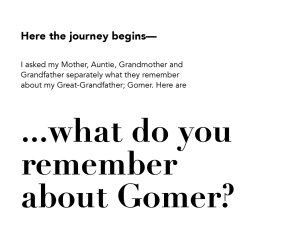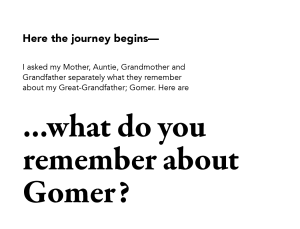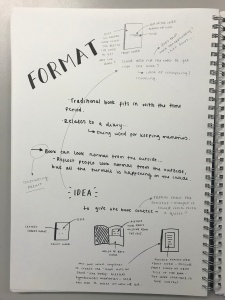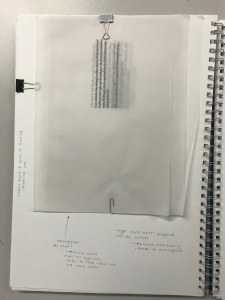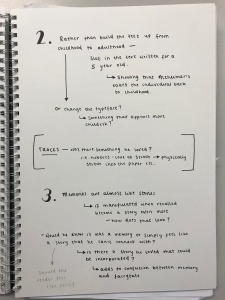Having completed my final ISTD book, I have inserted images below showcasing the final piece. Before the images is a statement surrounding the context of the boom to give a clearer sense of what it is about…
Gomer Lewis Latham is the name of both my Great-Grandfather and title of my publication. It is a book of discovery uncovering who Gomer was. I was never able to know him and have therefore set out to recover what is lost through personal discussions with my family…
Having only been two years old when Gomer passed away, I do not recall any memories of him. The structure of the narrative follows Gomer’s descent from a healthy and capable individual, to one suffering with Alzheimer’s; a disease that slowly engulfs the mind. Memories become lost, along with the ability to interact with the world.
The content of the book focuses on four voices, my Mother (Elaine), Auntie (Christine), Grandmother (Mavis) and Grandfather (Denzil). Each voice recalls their own memories and experiences shared with Gomer. To differentiate each voice, each has been assigned a colour and a weight from the font family; Cormorant Infant. It was important to select a font family as it is my family who are central to the narrative. The decision to use a serif typeface was for the traditional and historical connotations that are associated with serif typefaces. Additionally, I have my own voice running throughout as a point of reflection within the narrative in the typeface; Akkurat. I used a sans-serif typeface to contrast the serif typeface and provide a more contemporary interjection, highlighting the differentiation between past and present.
The use of typography and other visual elements have been brought together to emulate the journey of the disease. It begins with a controlled approach, revealing Gomer at his best, before small, but noticeable differences begin to take place. These are seen within the four vivid memories which include; repetition, blurred memories, gaps within memories and mistaking words.
Following the death of his wife, the use of typography becomes more postmodern, echoing the loss of history of such an era— the aim—to emulate the sporadic nature of Alzheimer’s during its final stages. The song ‘Amazing Grace’ features twice throughout the book as it was Gomer’s most loved song, but is also one that is widely known and can resonate with many people. The song is first seen in order, whereas, the second (although appears visually identical) does not read correctly through the disordered lyrics— highlighting the confusion that resides within.
The colours used have been picked from a photograph of Gomer, with the image itself seen throughout—in segments—as though gathering pieces to build a complete image of who he was. The photograph can then be seen as a whole at the end of the book, thus concluding the journey and revealing the man behind the name.
All in all, the overarching concept of the book highlights the loss of memories that is experienced as a result of Alzheimer’s. Our memories are what define us, encased in our bodies and recalled whenever we wish (or need), they are the narrative of our lives. Although Gomer became lost in himself through the loss of his memories, he lives on through the memories of others.
Overall I am extremely pleased with what I have created, having never made a book from start to finish before (especially a hard back cover), I knew it was going to be a challenge – but I did not anticipate for it to be as intense as it was. I feel the outcome itself really does celebrate the life of my great-grandfather showcasing it from him at his best through to the darker moments, when Alzheimers took its course.
I have definitely learnt a tremendous amount from completing the project, from talking to print studios, setting up artworks correctly and trying to wrap my head around paper stock, through to binding, tip ins and making a hard back cover by hand. That’s without the amount I have developed my knowledge on typography and the handling of type. I really do believe that I will be able to take all these new and developed skills with me to future projects and into industry.
Despite all of the challenges faced, it was a very fulfilling experience and I am really proud of the outcome produced. If I were to do it again, I would definitely talk to print studios earlier to know what is achievable and realistic as that would help to inform my design as well as understand the binding process better to know the time it takes. I would also try to work on my time management skills better and set myself earlier deadlines to ensure the work is completed with plenty of time to spare in case something does go wrong, in this case if something had gone wrong, I would not have had the time to rectify the issue (which is a little scary).
